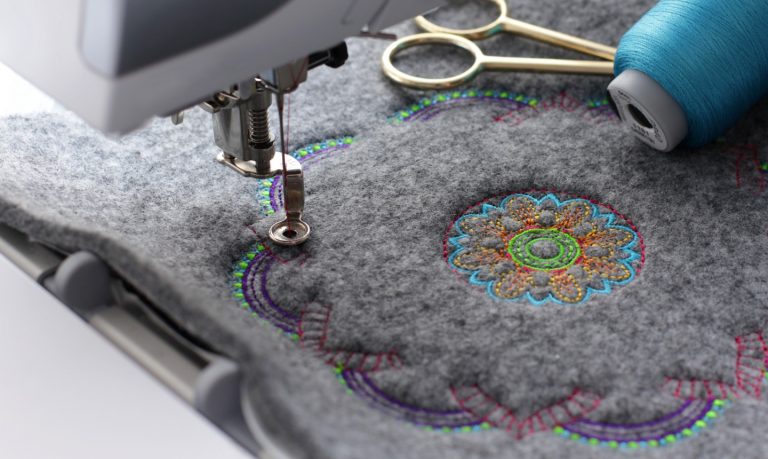Reliable Digitizing for Embroidery: Quick Turnaround
Reliable Digitizing for Embroidery: Quick Turnaround
Blog Article
Grasping the Embroidery Digitizing Refine: Your Ultimate Overview
Embroidery digitizing is a precise craft that calls for accuracy and proficiency to equate intricate layouts right into digital layouts for device embroidery. As artisans start this trip to grasp the embroidery digitizing procedure, an extensive understanding of the fundamentals establishes the foundation for excellence. Nonetheless, past the rudimentary expertise exists a realm of sophisticated software, specialized tools, and nuanced strategies waiting to be explored. By delving into the nuances of digitizing, one can open a globe of innovative opportunities and elevate their needlework projects to new heights.

Recognizing Embroidery Digitizing Essentials
Needlework digitizing basics form the structure upon which complex designs are equated into machine-readable styles for exact sewing. This first action in the embroidery digitizing process is vital for ensuring that the last embroidered product is a devoted representation of the original style. Comprehending needlework digitizing fundamentals entails grasping essential ideas such as stitch types, sew direction, density, padding, and draw payment.
Stitch types play a crucial duty in identifying the aesthetic and textural end result of the stitched style. By choosing the suitable stitch type, whether it be satin, fill, or running stitch, digitizers can accomplish the wanted result and improve the total high quality of the needlework. Furthermore, sew instructions influences the circulation and dimension of the style, while thickness identifies the spacing and protection of the stitches.
Additionally, underlay sewing supplies security to the layout by protecting the material and protecting against distortion throughout the embroidery process. Draw payment is an additional necessary consideration to counteract the all-natural tendency of material to agreement when sewn. Mastering these needlework digitizing essentials is essential for producing professional-quality embroidered items.
Picking the Right Digitizing Software Program
Selecting the ideal digitizing software is a critical choice that dramatically influences the efficiency and high quality of the embroidery digitizing procedure. Digitizing for Embroidery. When selecting the ideal digitizing software program, it is crucial to take into consideration factors such as the intricacy of designs you intend to produce, the user-friendliness of the software program, the degree of client assistance provided, and the compatibility with your needlework equipment
There are numerous digitizing software application alternatives readily available on the market, ranging from basic programs for newbies to innovative software program for specialist digitizers. Some preferred options include Wilcom EmbroideryStudio, Hatch Embroidery Software, and PulseID. These software packages supply a vast array of tools and functions to help you develop elaborate styles easily.
Before making a decision, it is recommended to discover the different software application choices via cost-free tests or demos to figure out you can check here which one finest matches your requirements. Furthermore, reading reviews and looking for referrals from experienced digitizers can give beneficial understandings into the staminas and weaknesses of each software program bundle (Digitizing for Embroidery). By carefully reviewing your needs and contrasting the attributes of different digitizing software application, you can make an enlightened selection that enhances your needlework digitizing workflow
Digitizing Devices and Techniques

Optimizing Design Settings for Needlework
Mastering the details of layout setups is fundamental in attaining ideal outcomes in the embroidery digitizing process, structure upon the structure laid by understanding digitizing devices and strategies. When enhancing style settings for embroidery, it is crucial to take into consideration elements such as stitch kind, density, padding, draw compensation, and enrollment. Registration settings straighten different aspects of the layout properly, preserving general layout honesty.

Troubleshooting Common Digitizing Issues
When encountering typical digitizing problems throughout the needlework procedure, it is important to comprehend the source and execute effective solutions immediately. One usual problem is stitch density issues, where stitches may be also thick, creating the material to pucker, or as well sporadic, leading to voids in the layout. Readjusting the stitch thickness settings in the digitizing browse around this web-site software can help fix this concern.
An additional regular obstacle is string breaks throughout the needlework procedure. This can occur due to numerous reasons such as incorrect stress settings, dull needles, or making use of low-grade thread. Making sure correct upkeep of the needlework maker, consisting of normal needle adjustments and stress changes, can decrease the event of string breaks.
Moreover, design enrollment errors can cause misaligned elements within the needlework layout. Examining the style alignment in the digitizing software application and making needed modifications before stitching can help in avoiding this problem. By addressing these usual digitizing issues without delay and properly, you can ensure a smoother embroidery process and high-grade finished products.
Final Thought
In verdict, understanding the embroidery digitizing procedure needs a strong understanding of the basics, the best option of software program, and knowledge of devices and strategies. Optimizing design settings and troubleshooting common digitizing concerns are important steps in ensuring top notch needlework outcomes. By following these steps vigilantly, one can achieve her explanation accuracy and effectiveness in the digitizing process.
Report this page